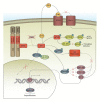NPM-ALK: The Prototypic Member of a Family of Oncogenic Fusion Tyrosine Kinases
- PMID: 22852078
- PMCID: PMC3407651
- DOI: 10.1155/2012/123253
NPM-ALK: The Prototypic Member of a Family of Oncogenic Fusion Tyrosine Kinases
Abstract
Anaplastic lymphoma kinase (ALK) was first identified in 1994 with the discovery that the gene encoding for this kinase was involved in the t(2;5)(p23;q35) chromosomal translocation observed in a subset of anaplastic large cell lymphoma (ALCL). The NPM-ALK fusion protein generated by this translocation is a constitutively active tyrosine kinase, and much research has focused on characterizing the signalling pathways and cellular activities this oncoprotein regulates in ALCL. We now know about the existence of nearly 20 distinct ALK translocation partners, and the fusion proteins resulting from these translocations play a critical role in the pathogenesis of a variety of cancers including subsets of large B-cell lymphomas, nonsmall cell lung carcinomas, and inflammatory myofibroblastic tumours. Moreover, the inhibition of ALK has been shown to be an effective treatment strategy in some of these malignancies. In this paper we will highlight malignancies where ALK translocations have been identified and discuss why ALK fusion proteins are constitutively active tyrosine kinases. Finally, using ALCL as an example, we will examine three key signalling pathways activated by NPM-ALK that contribute to proliferation and survival in ALCL.
Figures



References
-
- Pulford K, Lamant L, Morris SW, et al. Detection of anaplastic lymphoma kinase (ALK) and nucleolar protein nucleophosmin (NPM)-ALK proteins in normal and neoplastic cells with the monoclonal antibody ALK1. Blood. 1997;89(4):1394–1404. - PubMed
-
- Iwahara T, Fujimoto J, Wen D, et al. Molecular characterization of ALK, a receptor tyrosine kinase expressed specifically in the nervous system. Oncogene. 1997;14(4):439–449. - PubMed
-
- Morris SW, Naeve C, Mathew P, et al. ALK the chromosome 2 gene locus altered by the t(2;5) in non-Hodgkin’s lymphoma, encodes a novel neural receptor tyrosine kinase that is highly related to leukocyte tyrosine kinase (LTK) Oncogene. 1997;14(18):2175–2188. - PubMed
-
- Vernersson E, Khoo NKS, Henriksson ML, Roos G, Palmer RH, Hallberg B. Characterization of the expression of the ALK receptor tyrosine kinase in mice. Gene Expression Patterns. 2006;6(5):448–461. - PubMed
LinkOut - more resources
Full Text Sources

